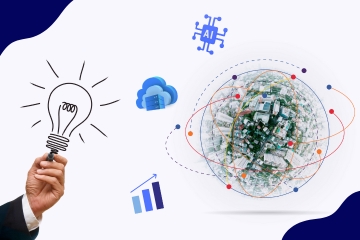In the ever-evolving realm of artificial intelligence, breakthroughs continue to astound us. One such revolutionary advancement is DALL-E, a cutting-edge AI model that has taken the art of image generation to unprecedented heights. Developed by OpenAI, the same organization behind the renowned GPT-3, DALL-E has captured the attention of the world with its ability to create astonishingly realistic images from standard textual descriptions.
This blog will explore the extraordinary world of DALL-E.
Introduction to DALL-E: Unveiling the Marvel
This remarkable AI model grants you the power to translate your wildest ideas and concepts into vivid, tangible images. Prepare to witness the magic as DALL-E bridges the gap between dreams and reality, providing a canvas where your imagination can come to life.
At its core, DALL-E is an AI model that combines the power of generative adversarial networks (GANs) and transformers to create mind-boggling images. Unlike traditional AI models, which operate on pre-existing images and manipulate them, DALL-E can generate entirely new images from scratch based on textual input. It is like having an AI artist who can bring the wildest concepts to life.
Let us see one such example:
The prompt- “Working on a laptop while sitting on the cloud in the sky”, generated this-
The Training Process: Feeding DALL-Es Imagination
DALL-E underwent an extensive training process to unlock its incredible potential by utilizing a comprehensive dataset of 20 billion parameters. These images encompassed various subjects, from everyday objects to surreal scenes, enabling DALL-E to develop an innate understanding of textures, shapes, and patterns. This comprehensive training gave DALL-E a solid foundation for creative image generation.
How DALL-E Works: Its Magic
DALL-E, the innovative AI technology developed by OpenAI, combines various components and techniques to achieve its impressive image generation capabilities:
- Generative Adversarial Networks (GANs): DALL-E utilizes GANs, comprising a generator and discriminator, to create and assess images based on text input. DALL-E refines its image generation skills through iterative training, producing increasingly realistic and captivating results.
- Transformers: DALL-E harnesses transformer neural networks to process text input effectively. By employing the attention mechanism within transformers, DALL-E comprehends the relationships between different elements described in the input, enabling it to generate coherent and contextually relevant images.
- Zero-Shot Text-to-Image Generation: DALL-E can generate images based on prior knowledge, eliminating the need for specific training on individual concepts. This zero-shot capability empowers DALL-E to produce diverse and imaginative visuals.
- CLIP Model Integration: DALL-E output undergoes evaluation using the CLIP model, which provides appropriate captions for the generated images. This integration ensures the quality and relevance of the generated visuals.
- DALL-E 1 and DALL-E 2: DALL-E development progressed through different versions. DALL-E 1 employed a discrete variational autoencoder (dVAE) to generate images from text prompts. DALL-E 2 built upon the methods used in DALL-E 1, resulting in more sophisticated and photorealistic image generation.
- Diffusion Model with CLIP Integration: DALL-E incorporates a diffusion model and CLIP integration to achieve higher-quality output. This integration enhances the realism and fidelity of the generated images.
These combined techniques and advancements establish DALL-E as a groundbreaking AI technology that transforms textual prompts into visually stunning and conceptually rich images.
Use Cases of DALL-E: An artist brush guided by an AI hand
DALL-E, with its exceptional image generation capabilities, finds applications in a wide range of domains, bringing creative inspiration and innovation to various industries:
- Creative Inspiration: DALL-E serves as a wellspring of creative inspiration, enabling artists, designers, and writers to explore new concepts and visualize their ideas in unprecedented ways. It unleashes imagination by transforming textual descriptions into captivating and visually stunning images as a muse for creative endeavors.
- Entertainment: In the realm of entertainment, DALL-E opens up endless possibilities for visual storytelling. It can generate unique characters, surreal landscapes, and fantastical creatures, enriching the worlds depicted in movies, video games, and virtual reality experiences.
- Education: DALL-E holds great potential as an educational tool, allowing students to illustrate their ideas and concepts vividly. It enhances learning experiences by providing visual representations that aid comprehension and retention. Students can explore historical events, scientific concepts, or even literary works by bringing them to life through DALL-E imaginative image generation.
- Advertising and Marketing: Leveraging DALL-E, advertisers and marketers can create visually compelling and memorable campaigns. It enables the generation of eye-catching graphics and illustrations tailored to specific products or brand messaging, enhancing audience engagement and brand recognition.
- Product Design: DALL-E ability to generate photorealistic images facilitates product design processes. Designers can visualize concepts, prototypes, and variations quickly, enabling faster iterations and refining designs before physical production. This accelerates the innovation cycle and streamlines the product development workflow.
- Art: DALL-E blurs the line between artificial intelligence and artistic expression. Artists can collaborate with DALL-E to bring their visions to life or explore entirely new artistic styles. DALL-E becomes a tool for artistic experimentation and creation by seamlessly translating abstract concepts into visually striking images.
- Fashion Design: Fashion designers can leverage DALL-E to ideate and conceptualize unique garments and textile patterns. It assists in visualizing and refining design concepts, enabling designers to push boundaries, create avant-garde collections, and bring their fashion visions into reality.
Proprietary Technology
DALL-E is a proprietary technology developed exclusively by OpenAI, and its source code is not publicly accessible. As a closed-source system, the inner workings and algorithms behind DALL-E remain confidential and exclusive to OpenAI.
Cons:
- Complexity: Understanding and utilizing DALL-E underlying technology requires AI and deep learning expertise.
- Resource Intensive: Generating high-quality images with DALL-E may require substantial computational resources.
- Cost: Access to DALL-E may involve associated expenses through credits or cost-per-image models.
- Limited Control: Users may have limited control over the exact output, requiring iterations to achieve desired results.
- Ethical Considerations: Ethical considerations regarding privacy, bias, and misuse should be considered when using DALL-E
Conclusion
DALL-E has ushered in a new era of AI image generation, merging art and technology awe-inspiringly. Its ability to create vivid, imaginative visuals based on textual input demonstrates the vast creative potential of artificial intelligence. As DALL-E continues to evolve, we can only begin to imagine its profound impact on various industries and how we perceive the convergence of human creativity and machine intelligence. The journey has just started, and the future holds boundless possibilities with DALL-E leading the way.






Comments